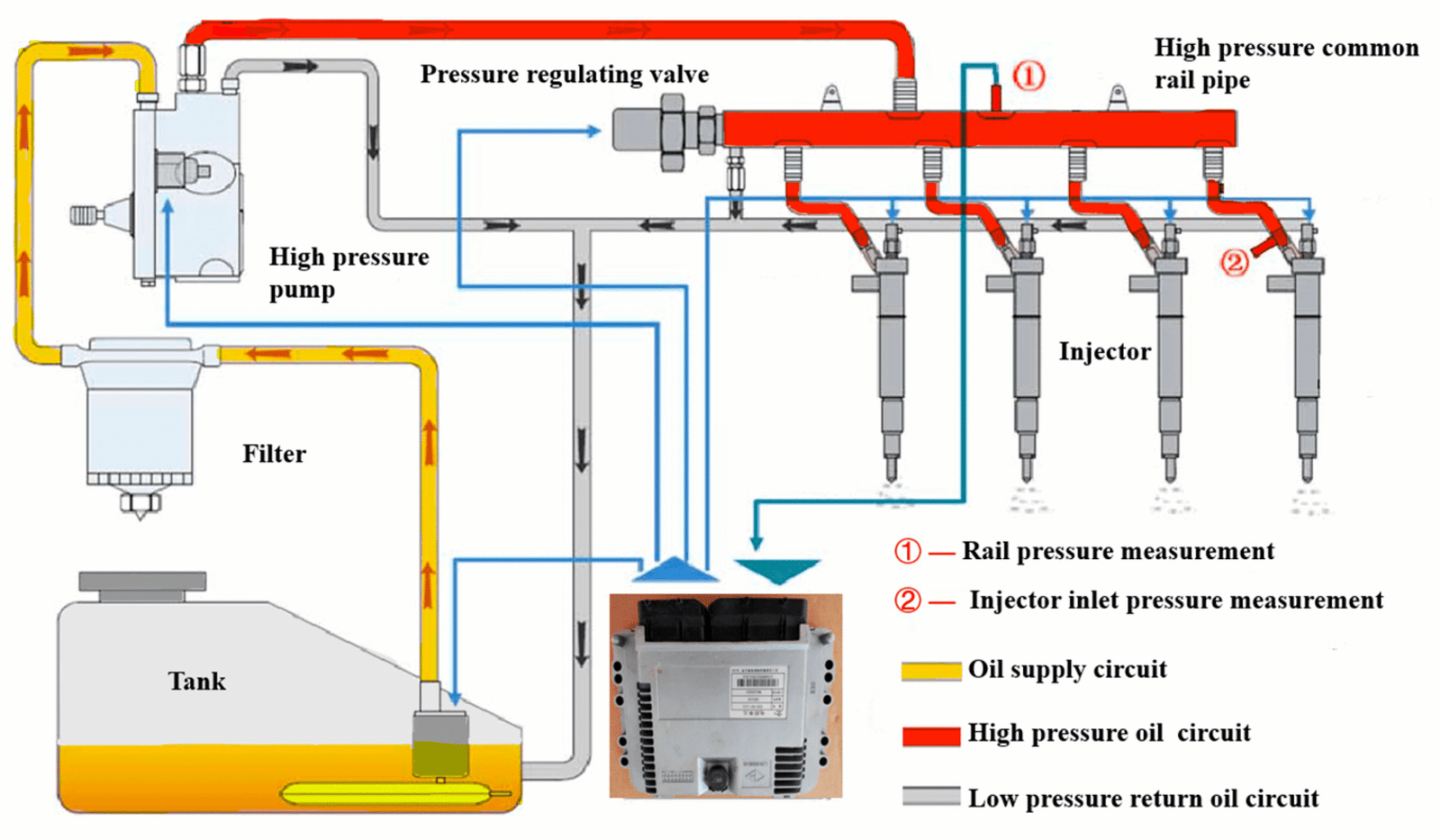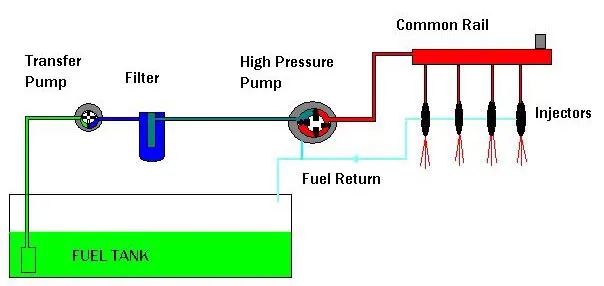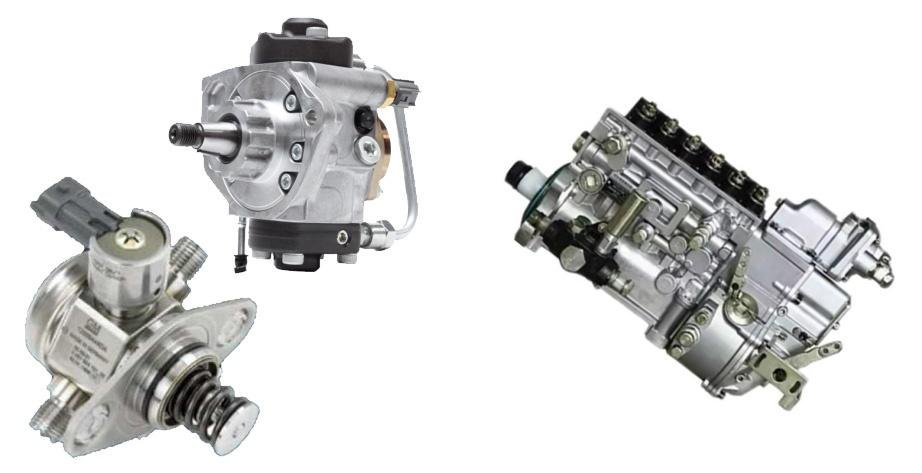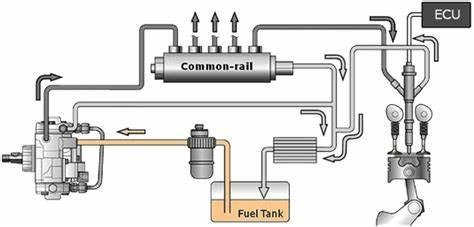
High-pressure common rail
High-pressure common rail technology refers to a fuel supply method in which the generation of injection pressure and the injection process are completely separated from each other in a closed-loop system consisting of a high-pressure fuel pump, a pressure sensor, and an ECU. The high-pressure fuel pump delivers high-pressure fuel to the common fuel supply pipe, and through precise control of the oil pressure in the common fuel supply pipe, the size of the high-pressure fuel pipe pressure is independent of the engine’s rotational speed, so that the change of the fuel supply pressure with the engine’s rotational speed of diesel can be greatly reduced. The ECU controls the injection volume of the injector, which depends on the pressure of the fuel rail (common fuel supply pipe) and the duration of the opening time of the solenoid valve.

What does the high-pressure common rail do?
The high-pressure fuel pump lifts the fuel to the common supply line, where it is injected directly into the cylinder by controlling the injectors. The high-pressure common rail completely separates the injection process from the oil pressure generation, so that the supply pressure is not affected by the engine speed.
Advantages of high-pressure common rail:
- The injection pressure in the common rail system is flexibly adjustable to determine the optimum injection pressure required for different operating conditions, thus optimizing the diesel engine’s overall performance.
- The injection timing can be flexibly controlled independently, and together with the high injection pressure (120MPa-200MPa), NOx and particulate matter (PM) can be controlled at the same time within a small value to meet the emission requirements.
- Flexible control of the injection rate change, realizing the ideal injection law, easy-to-realize pre-injection, and multiple injection, not only reduce the NOx of diesel engines but also ensure excellent power and economy.
- By the solenoid valve control injection, control precision is higher, there will be no bubbles in the high-pressure oil circuit,t and the phenomenon of zero residual pressure, so in the range of diesel engine operation, the cycle of small changes in the amount of injection, uneven oil supply to the cylinders can be improved, thereby reducing the vibration of the diesel engine and reduce emissions.

Representative Car Models:
At the end of 1999, the Smart with a 3-cylinder common rail diesel engine was born, with a displacement of only 799mL, a maximum power of 30kW, and a maximum torque of 100Nm at 1800-2800rpm. Mercedes-Benz launched the E320 with a second-generation common rail engine, with a maximum power of 150kW/1000rpm and a torque of 250Nm, and 85% of the peak torque can be obtained at 1400rpm, and 500Nm of peak torque can be realized within a wide area from 1800 to 2600rpm. 85% of the peak torque can be obtained at 1400rpm, and a peak torque of 500Nm can be realized in a wide area from 1800 to 2600rpm. the acceleration time from 0 to 100km/h is only 7.7 seconds, and the top speed is 243km/h. the combined fuel consumption is 6.9L/100km, and the 80L fuel tank makes the range up to 1,000km. while the petrol-equipped The E320’s combined fuel consumption is 9.9L/100km.
Technical overview:
In diesel engines, high-speed operation so that the diesel fuel injection process time is only a few thousandths of a second, experiments have proved that in the injection process of high-pressure fuel pipe pressure in various places is with the time and location of the different changes. Due to the compressibility of diesel fuel and the pressure fluctuations of diesel fuel in the high-pressure fuel line, the actual state of injection and injection pumps specified by the plunger fuel supply law is significantly different. Pressure fluctuations in the fuel line sometimes also after the main injection, so that the pressure in the high-pressure fuel line rises again, to make the injector needle valve open the pressure, the needle valve has been closed and reopened to produce the second injection phenomenon, due to the second injection is not possible to complete combustion, thus increasing the smoke and hydrocarbon (HC) emissions, fuel consumption increases. In addition, the residual pressure in the high-pressure fuel line will change after each injection cycle, resulting in unstable injection, especially in the low-speed region that is prone to the above phenomenon, and when it is serious, not only uneven injection but also intermittent non-injection phenomenon. To solve this defect of diesel engine fuel pressure change, modern diesel engine adopts a kind of technology called common rail.
High-pressure common rail technology refers to a closed-loop system composed of the high-pressure fuel pump, pressure sensor, and ECU, the generation of injection pressure and the injection process are completely separate from each other, a fuel supply method, by the high-pressure fuel pump to deliver high-pressure fuel to the common fuel supply pipe, through the – on the common fuel supply pipe in the oil pressure to achieve precise control, so that the size of the high-pressure fuel pipe pressure is independent of the engine’s rotational speed, which can significantly reduce the diesel engine fuel supply pressure The ECU controls the injection volume of the injector, which depends on the pressure of the fuel rail (common fuel supply pipe) and the duration of the opening time of the solenoid valve.
Principle of Common Rail Technology
The high-pressure common rail system is mainly composed of an electronic control unit, a high-pressure fuel pump, a pressure accumulator (common rail pipe), an electronically controlled injector, and various sensors. The low-pressure fuel pump will fuel the high-pressure oil pump, the high-pressure oil pump will fuel pressurized into the high-pressure oil rail (accumulator), high-pressure oil rail pressure by the electronic control unit according to the oil rail pressure sensor measurement of the rail pressure and the need to regulate the high-pressure oil rail fuel through the high-pressure oil pipe, according to the machine’s operating conditions, by the electronic control unit to determine the appropriate fuel injection timing, fuel injection duration of the electro-hydraulic control of the electronic fuel injector The fuel is injected into the cylinder.

High-pressure oil pump:
The design criterion for the supply volume of the high-pressure pump is that the sum of the injection and control volume of the diesel engine must be guaranteed in all cases, as well as the fuel volume change requirements during starting and acceleration. Since the generation of the injection pressure in the common rail system is independent of the fuel injection process and the injection timing is not ensured by the cam of the high-pressure oil pump, the compression cam of the high-pressure oil pump can be designed by the design principles of lowest peak torque, lowest contact stress, and most wear-resistant cam.
Most companies utilize a triplex radial piston pump driven by a diesel engine to generate pressures up to 135MPa. The high-pressure oil pump utilizes multiple pressure cams in each pressure unit, reducing peak torque to 1/9th of that of a conventional high-pressure oil pump, as well as a more uniform load, which reduces operating noise. The control of the pressure in the high-pressure common rail chamber in the system is realized by draining the fuel in the common rail chamber. To reduce power loss, in the case of a small injection volume, one of the pressure units in the triplex radial piston pump will be shut down to reduce the fuel supply.
High-pressure fuel rail (common rail pipe)
The common rail pipe distributes the high-pressure fuel supplied by the fuel supply pump to each injector and acts as a pressure accumulator. Its volume should cut the high-pressure oil pump supply pressure fluctuations, and each injector should be injected by the pressure oscillation so that the pressure fluctuations in the high-pressure oil rail are under 5MPa. However, its volume should not be too large to ensure that the common rail has enough pressure response speed to quickly track changes in diesel engine conditions.
The high-pressure common rail pipe is also fitted with a pressure sensor, a flow snubber (flow restrictor), and a pressure limiter. The pressure sensor provides the ECU with a pressure signal for the high-pressure fuel rail; the flow snubber (flow restrictor) ensures that the fuel supply to the injectors is cut off in the event of fuel leakage from the injectors and reduces pressure fluctuations in the common rail and the high-pressure fuel line; and the pressure restrictor ensures that the high-pressure fuel rail is quickly relieved of the pressure in the high-pressure fuel rail in the event of pressure anomalies.

Electronically controlled injectors
The electronically controlled injector is the most critical and complex component of the common rail fuel system, its role according to the control signals issued by the ECU, through the control of the solenoid valve open and close, the high-pressure fuel rail in the fuel with the best injection timing, injection volume, and injection rate sprayed into the combustion chamber of the diesel engine.
To achieve the predetermined injection shape, it is necessary to carry out a reasonable and optimized design of the injector. The size of the volume of the control chamber determines the sensitivity of the needle valve when it opens, the volume of the control chamber is too large, the needle valve at the end of the injection can not quickly cut off the fuel, so that the fuel atomization of the late bad; control chamber volume is too small, can not provide enough effective stroke to the needle valve, so that the injection process of the flow resistance to increase, therefore, the volume of the control chamber should also be based on the model’s maximum fuel injection volume reasonable choice.
In addition, the minimum injection pressure of the injector nozzle depends on the flow rate of the return and inlet volume holes and the end area of the control piston. Thus after determining the structural dimensions of the inlet volume orifice, the return volume orifice, and the control chamber, a stable, shortest injection process with the needle valve of the injector nozzle fully open is determined, and at the same time the stable minimum injection volume of the injector nozzle is determined. The reduced volume of the control chamber allows for a faster response of the needle valve and a smaller effect of fuel temperature on the nozzle injection volume.
However, the volume of the control chamber cannot be reduced indefinitely; it should be able to ensure the lift of the injector nozzle needle valve to allow the needle valve to open fully. The two control orifices determine the dynamic pressure in the control chamber, and hence the law of motion of the needle valve, by carefully adjusting the flow coefficients of these two orifices, the desired law of injection can be produced.
Because the injection pressure of the high-pressure common rail injection system is very high, the cross-sectional area of the spray hole of its injector nozzle is very small, for example, the diameter of the spray hole of the injector nozzle of the BOSCH company is 0.169mm×6. With such a small diameter of the spray hole and such a high injection pressure, the fuel flow is in an extremely unstable state, and the spray cone angle of the oil beam becomes larger, the fuel atomization is better, but the penetration distance becomes smaller, therefore, the original diesel engine should be changed. Therefore, the swirl strength of the intake air and the shape of the combustion chamber structure should be changed to ensure the best combustion process.

